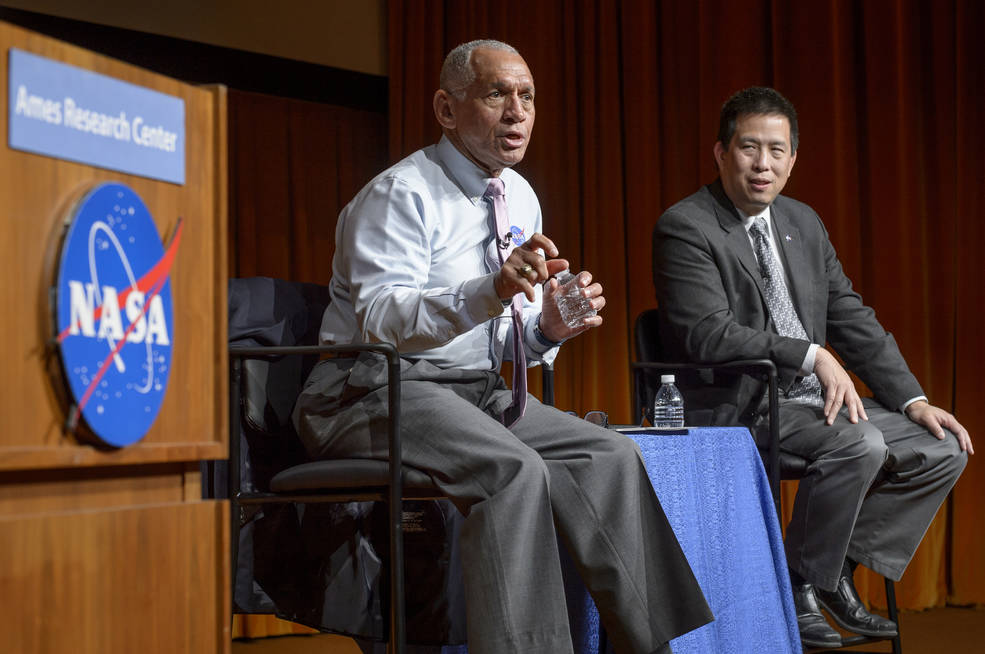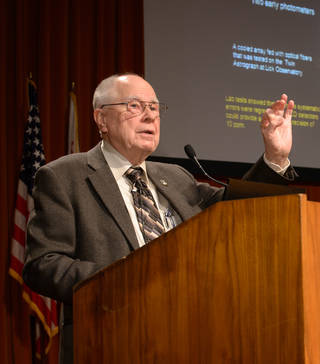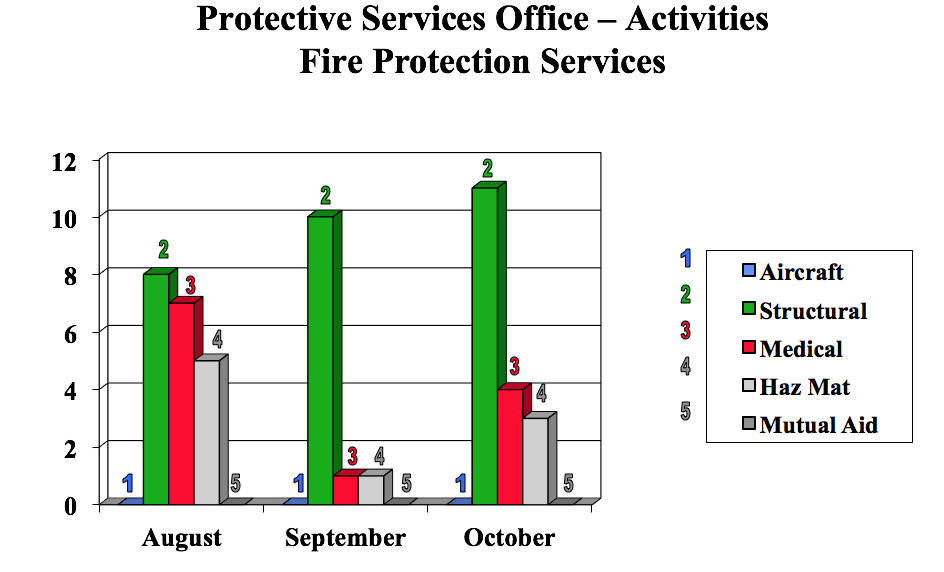NASA Administrator Charlie Bolden Visits Ames and Speaks at All Hands
Innovative Talks and Technology Showcased at Agency’s Innovation Mission Day Event at Ames
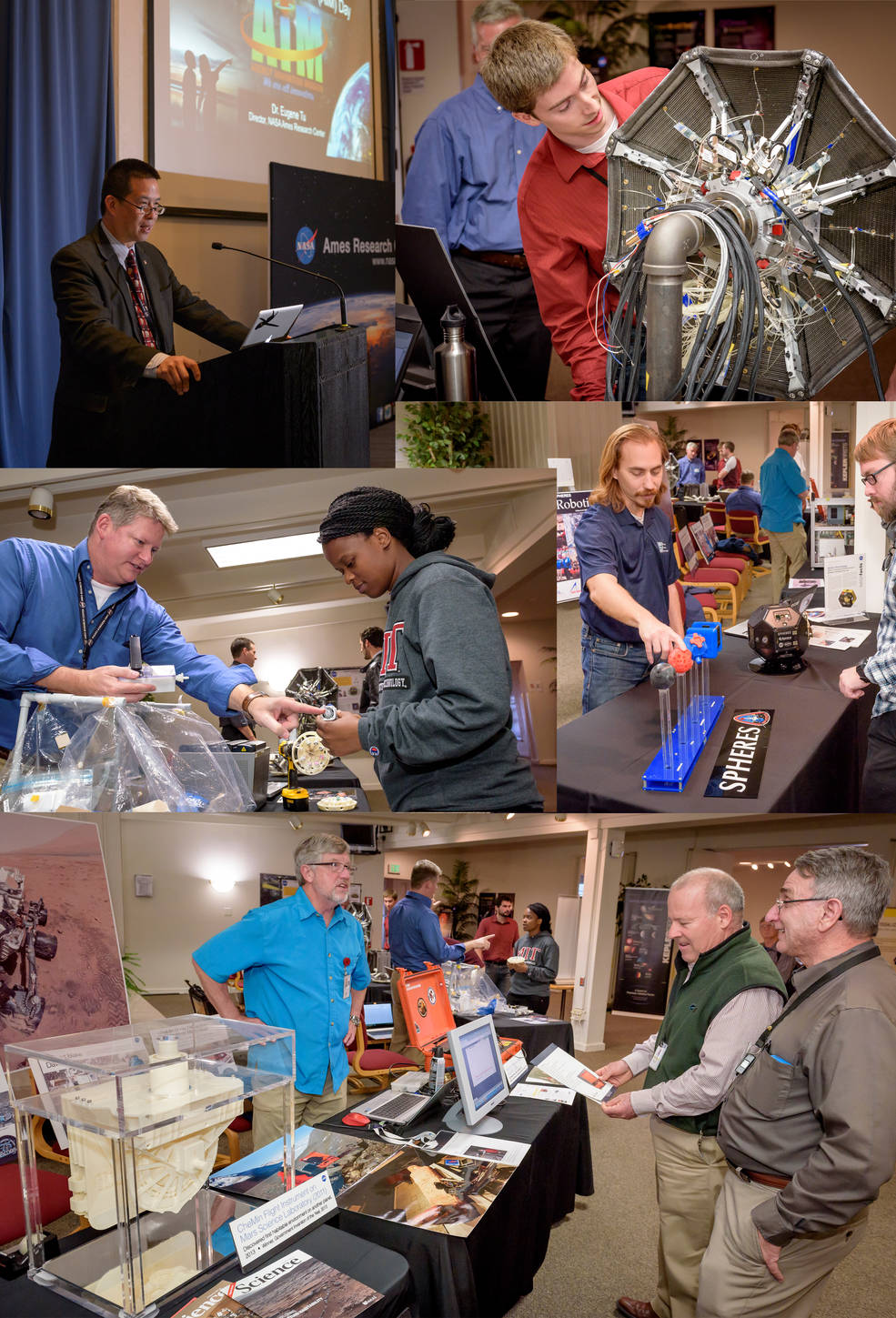
Attendees Enjoy Veteran’s Day Luncheon Hosted by the Ames Veterans Committee
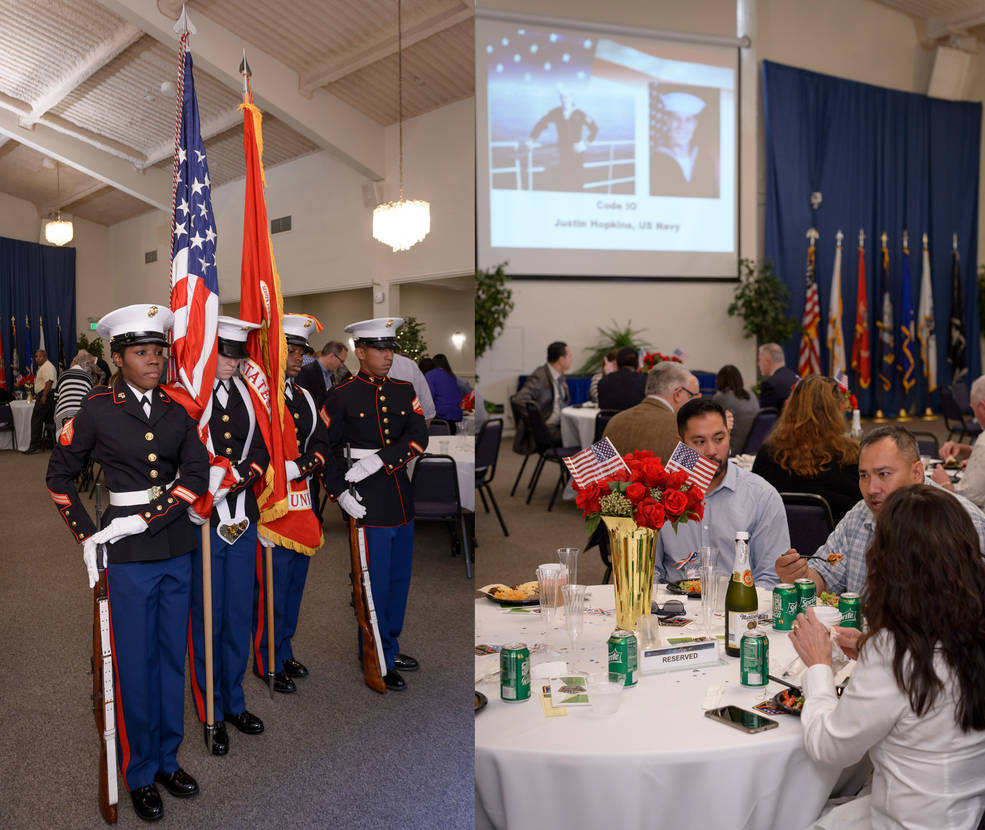
All Hands Covers Workforce Planning and Support Roles
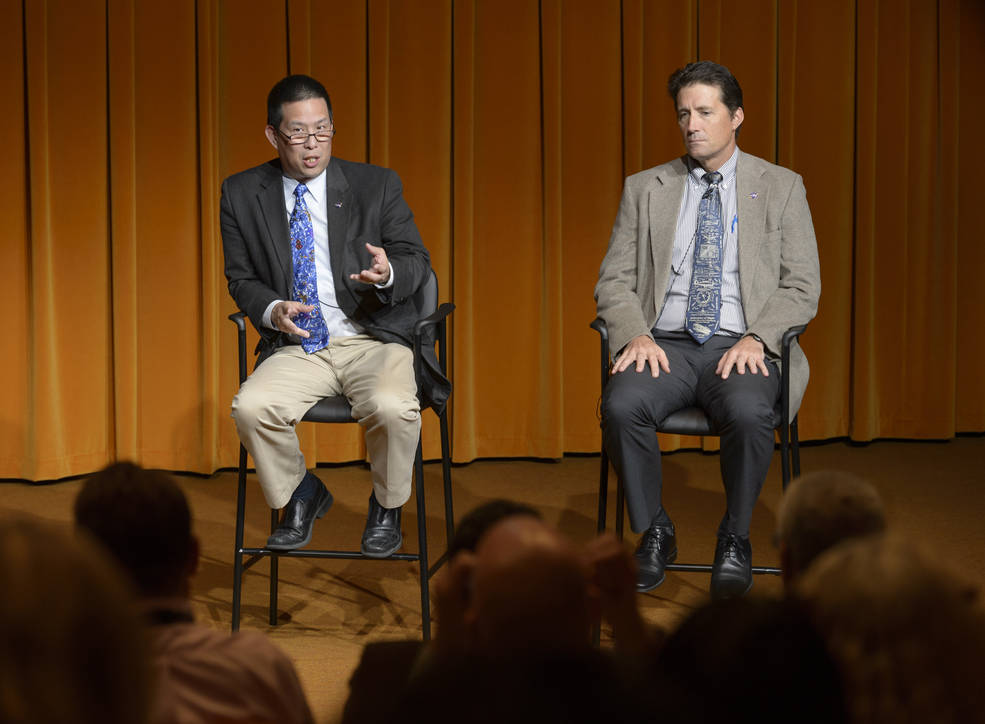
NASA’s Flying Observatory Expands New Frontiers in Solar System and Beyond
by Nicholas Veronico
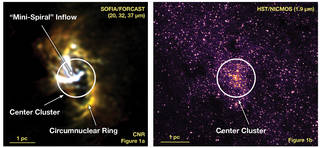
NASA’s Stratospheric Observatory for Infrared Astronomy (SOFIA) will soon be studying Neptune’s giant moon, Triton and following-up on Hubble’s recent sighting of water plumes on Jupiter’s moon Europa. According to recently completed plans for the 2017 observing campaign, about half of the research time for SOFIA will run the gamut from studies of planets to observations of comets and asteroids orbiting other stars and super massive black holes in the centers of galaxies beyond our own. The other half will focus on star formation and the interstellar medium, the areas of dust and gas in the universe, including a vast turbulent region encircling the center of our Milky Way galaxy.
A total of 535 observing hours have been awarded for SOFIA’s Science Cycle 5, which runs from February 2017 through January 2018, and the selected programs span the entire field of astronomy from planetary science to extragalactic investigations. Triton, only one-third of a light year from Earth, will be one of the closest objects studied by NASA’s flying observatory while the farthest observation will study a super massive black hole approximately 12 billion light years away.
SOFIA is a is a joint program between NASA and the German Aerospace Center and is a Boeing 747SP jetliner modified to carry a 100-inch diameter telescope that uses eight instruments to study the universe at infrared wavelengths that cannot be detected from ground-based observatories. Cycle 5 provides 455 research hours to U.S. programs and 80 hours to German programs
For entire article, visit: https://www.nasa.gov/feature/nasa-s-flying-observatory-expanding-new-frontiers-in-the-solar-system-and-beyond
NASA Field Test Focuses on Science of Lava Terrains, like Early Mars
“One Giant Terrestrial Leap Toward Exploring Mars”
by Kimberly Williams
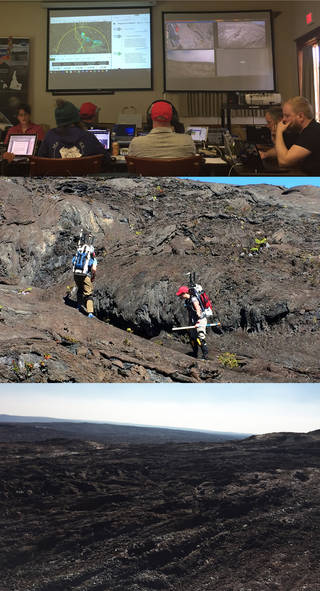
Was Mars home to microbial life? Is it today? What can it teach us about life elsewhere in the cosmos or how life began on Earth? What clues will we discover about Earth’s past, present and future? NASA and its partners have been traversing the volcanic lava terrains of Hawai’i to answer these fundamental questions about life beyond Earth.
Engineers, scientists and software technology experts are working together to gain essential knowledge in preparing for human and robotic exploration of Mars and its moons, our moon and near-Earth asteroids.
The Biologic Analog Science Associated with Lava Terrains (BASALT) project, led by NASA Ames, conducted an 18-day field science expedition under simulated Mars mission conditions on the Big Island of Hawaii, Nov. 1-18, 2016. BASALT is funded by the Planetary Science and Technology through Analog Research (PSTAR), as part of NASA’s Science Mission Directorate (SMD).
Earlier this summer, the project conducted field studies related to present-day Mars, at lava flows in Idaho. This field test focused on terrestrial volcanic terrains as analog environments for early Mars along the lava flows of Mauna Ulu.
“Our team is seeking to understand the habitability potential of basalt-rich volcanic environments as an analog to early Mars,” said Dr. Darlene Lim, principal investigator of the BASALT program at Ames. “However, we added a twist to our scientific fieldwork by conducting it under simulated Mars mission constraints.” Analog environments provide NASA with data about strengths, limitations and the validity of exploration operations and helps to define ways to enhance scientific exploration. Analog locations are identified based on their physical similarities to environments on other worlds.
From the lava flows in Hawaii, “astronauts” collected basalt rock samples for biological and geological science studies to characterize life and life-related chemistry in basaltic environments representing these two epochs of Martian history. From mission control, located nearly 15 km away, communication latencies and bandwidth limitations were simulated, to reflect architectural expectations during a Mars mission.
Because communication delays between an astronaut crew on Mars and their science team on Earth will range from 4 to 22 minutes one way (8-40 minutes round-trip), astronauts will need to be able to manage their own activities while also being able to receive input from science mission control. The astronauts used wrist-displays that included a mission-planning tool called Playbook, to operate autonomously during lapses in communication. In addition to Playbook, NASA’s Exploration Ground Data Systems (xGDS) allowed the science team to track progress of the extra-vehicular (EV) traverses. The xGDS is an interactive suite of web software that syncs real world data from sensors and human observations with digital maps for analysis. Both xGDS and Playbook were developed by NASA Ames to enable research for future manned deep space missions and increased autonomy by International Space Station astronauts.
“We’re testing out methods to support our astronauts on their mission of scientific discovery under these rather strenuous working conditions. Are these the tools we need to support our mission both on Mars and on Earth so that we can ensure scientific return? These questions drive our research here in Hawaii,” says Lim.
A major benefit to the BASALT project is the collaboration of scientists, engineers, operations specialists and former astronauts that bring their diverse backgrounds and perspectives to the field, in an interdisciplinary manner, to help answer these questions.
The diversity of basalts collected was selected based on geological and biological features ranging from alteration, fumarole deposits, etc., and will be later analyzed in the laboratory. The in-situ, or “in place,” sample characterizations were performed using portable infrared spectrometer and thermal imaging science instruments that took images of the spectra from the samples. These mobile assessment tools enabled the BASALT team to select samples quickly and safely in full contact, without influence of scattered light and atmosphere.
Following the completion of a traverse, this collection of experts analyzed the day’s science investigations and operational successes using quantitative rankings.
NASA expects this science-driven exploration program to result in new scientific, operational and technological capabilities that will serve to enable and inform the next generation of human-robotic planetary exploration.
NASA Centers involved are Ames Research Center in Silicon Valley, California; Johnson Space Center in Houston, Texas; Kennedy Space Center in Florida; Goddard Space Flight Center in Greenbelt, Maryland; Marshall Space Flight Center in Huntsville, Alabama; and NASA Headquarters in Washington.
Participants from outside of NASA include: Cornell University; Purdue University; Idaho State University; University of Edinburgh, Scotland; McMaster University and Western University, Canada; Massachusetts Institute of Technology; SETI Institute; Arizona State University; Louisiana State University; University of Hawaii, Hilo; PISCES; Johns Hopkins University, Applied Physics Laboratory; Korea Institute of Geoscience and Mineral Resources; and the Canadian Astronaut Office.
For more information about future NASA human and robotic exploration missions, visit: https://www.nasa.gov/directorates/heo/index.html
Learn more about the BASALT field tests at: http://spacescience.arc.nasa.gov/basalt/
American Association for the Advancement of Science Honors Kepler Visionary
by Michele Johnson
William J. Borucki, principal investigator for NASA’s Kepler mission at NASA Ames, has been named a Fellow by the American Association for the Advancement of Science (AAAS).
Borucki is recognized for distinguished contributions to the field of astrophysics, with his leadership of the Kepler Mission leading to the discovery of thousands of exoplanets.
“This is a worthy acknowledgment of Bill Borucki’s vision and the commitment of the Kepler mission team,” said Michael Bicay, director for science at Ames. “Kepler has re-written the narrative in contemporary astronomy by proving what scientists long suspected—that planets are common in our Milky Way galaxy. This essential leap in knowledge allows us to take the next important steps in ascertaining whether life could exist elsewhere.”
Kepler is the first NASA mission to find Earth-size planets in the habitable zone–the region in a planetary system where liquid water might pool on the surface of an orbiting planet. To-date, Kepler has identified more than 5,100 planet candidates, of which more than 2,500 have been verified as bona fide planets confirming that planets are everywhere.
Beginning in 1992, with the first proposal for the Kepler mission to NASA Headquarters, Borucki led a determined team through a decade of tackling questions about technology that had not been flown in space yet. With the final concerns addressed, the mission once deemed impossible was approved for flight in 2000.
“I am truly honored to be named a fellow by an organization that has a proud history of promoting advances in the sciences,” said Borucki.
For entire article, visit: https://www.nasa.gov/feature/kepler/nasa-kepler-visionary-honored-by-american-association-for-the-advancement-of-science
Thousands Visit Ames Exhibits at Bay Area Science Festival’s Discovery Day
NASA participated with various exhibits in this years Bay Area Science Festival’s (BASF) Discovery Day at AT&T Park in San Francisco, on Nov. 5, 2016. The free event featured more than 200 hands-on activities and opportunities to meet local scientists and engineers. The festival expected to host more than 35,000 students, families and teachers celebrating the wonders of Science, Technology, Engineering and Mathematics (STEM). For more information about the Bay Area Science Festival, visit: http://www.bayareascience.org
Health and Safety Fair Provides Options for Avoiding Injuries and Illnesses
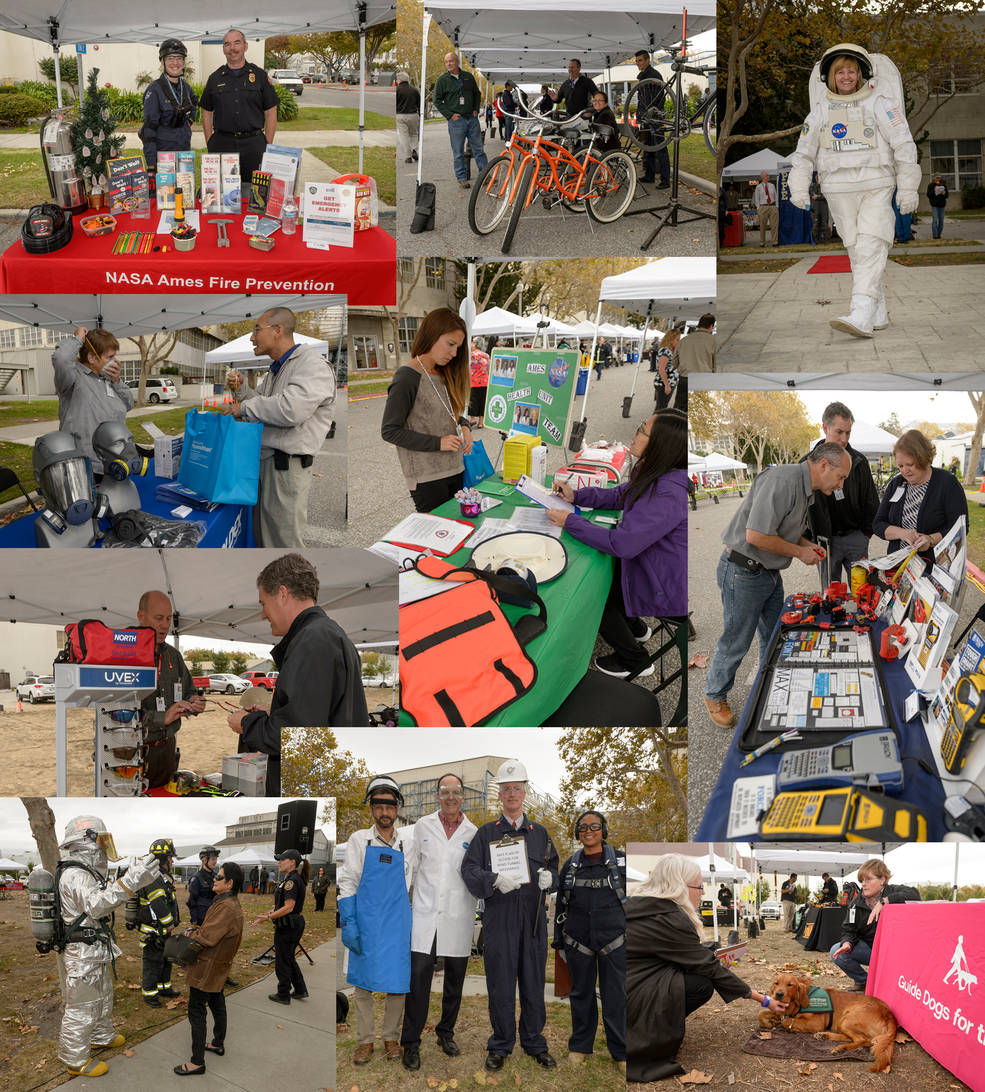
Sinister and Cute Characters Afoot at the Annual Halloween Costume Contest
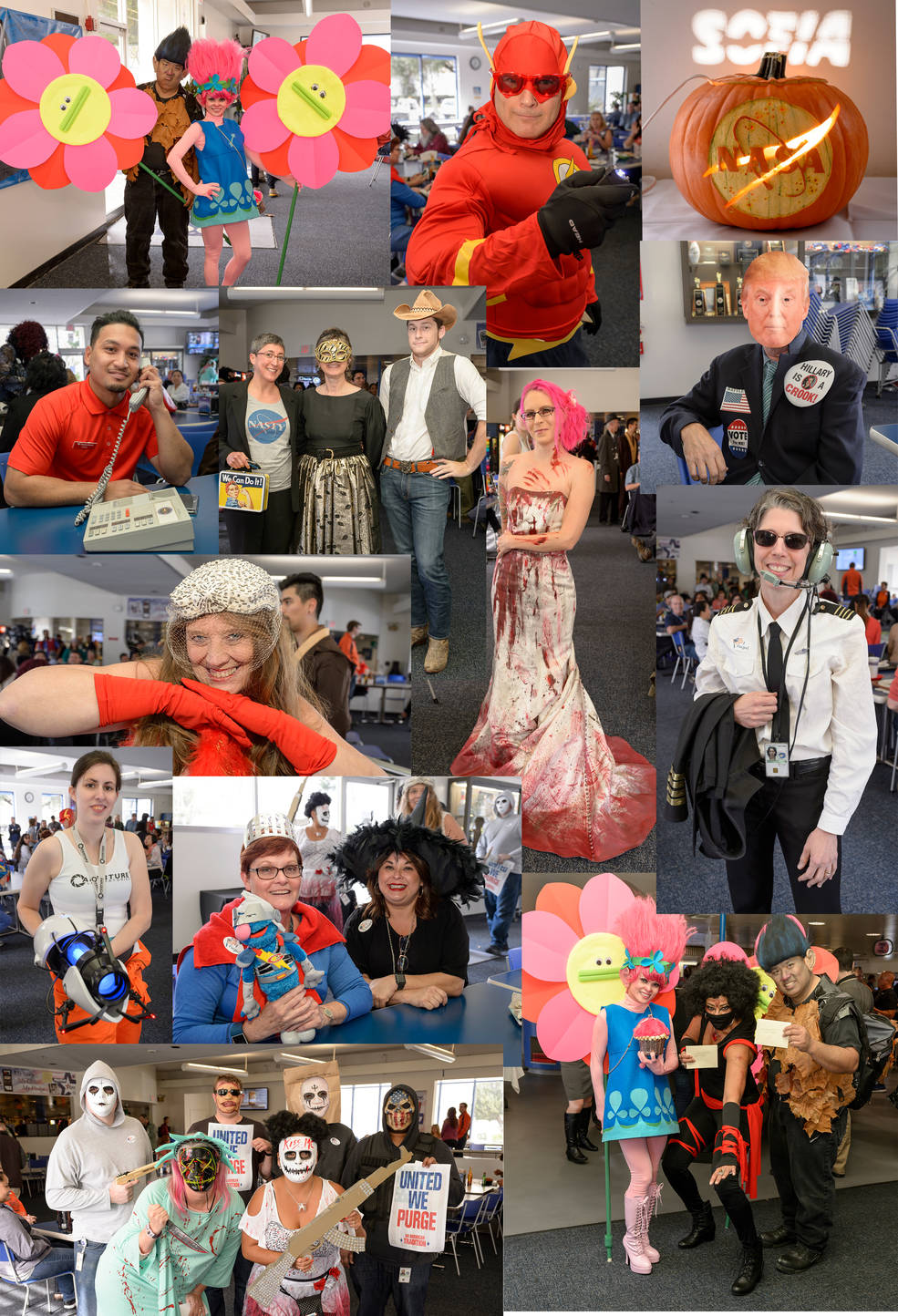
In Memoriam …
Theresa (Terri) Bracero, Executive Secretary at Ames, Passes Away
Theresa (Terri) Bracero, aged 64, an Executive Secretary at NASA Ames, died Saturday, Oct. 22, 2016, surrounded by family and friends, after battling lymphoblastic leukemia. Born in Mayaguez, Puerto Rico, she was raised in New York City. Theresa graduated from Morris High School in the New York City borough of the Bronx. In 1978, Theresa joined NASA Ames and concluded her career path on July 3, 2016 with an outstanding 38 years. Known for her intellectual prowess, quick wit and unfailing good humor, Theresa supported several Aeronautic departments serving diligently as a records liaison officer and a property custodian. She received numerous time off and performance awards. Theresa was passionate about her family, her rich cultural heritage and living her life in service of others. Theresa is survived by her husband of 45 years, Francisco J. Bracero; her two daughters, Melanie and Melissa, granddaughter, Savannah, her brother, Wilfred Soler; her cousin, Brenda Munar; a loving extended family; and by her closest friends. In lieu of flowers, please consider a donation to the St. Jude Children’s Research Hospital at 501 St Jude Place, Memphis, TN 38105, Source Code: IIQ160788777 or donate by phone at 800-805-5856. A memorial service was held Monday, Nov. 7, at the Moffett Field Chapel.
A statistical summary of activities of the Protective Service Division’s Security/Law Enforcement and Fire Protection Services units for the period ending October 2016 is shown below
Click here to view:
Ames Ongoing Clubs/Monthly Events
NASA Ames Exchange Information
Information about products, services and opportunities provided to the employee and contractor community by the Ames Exchange Council. Visit our web site at: http://exchange.arc.nasa.gov
Beyond Galileo Gift Shop N-235 in the cafeteria, 8:00 a.m. – 2:00 p.m., ext. 4-6873
Visitor Center Gift Shop (Exploration Center), Tues-Fri, 10:00 a.m. – 4:00 p.m., Sat. – Sun, noon – 4:00 p.m., ext. 4-5412 Remember to purchase your baby shower, birthday and holiday gifts at Ames’ two gift shops!
Mega Bites Cafeteria N-235, Manager Jason Hamed, ext. 4-5969, Mon – Fri, 6:00 a.m. – 2:00 p.m., ext. 4-5969/Catering contact Karen Mcintyre, 650 444-2241
The SpaceBar: Subs & Burgers, Bldg. 3, Hours are: Mon – Fri, from 11:00 a.m. – 7:00 p.m. See: http://exchange.arc.nasa.gov/cafe/menu.html for menu items.
NASA Lodge (Bldg. 19) (650) 603-7100 Where to stay when you’re too tired to drive home? What about the lodge?! Current Rates: Bldg. 19 (43 rooms), rate: $65/night ($5 each additional adult); Bldg. 583 A&B (150 rooms), rate: $55/night ($5 each additional adult); B547 rate $60/night (for large groups)
Ames Swim Center (N-109) (650) 603-8025 The swimming pool is now open. Hours of operation are as follows (lap swim only): Mon – Fri, 10:00 a.m. – 1:00 p.m. and M-F 3:00 p.m. – 6:00 p.m. The pool is heated year round. POC: Ryan Storms, pool manager (650) 603-8025. Memberships: Yearly access $350, 3 Month $100, Single day use $5
Exchange Basketball Gym, Building 2, POC: Manager Bryan Henshaw, (650) 603-9717, Hours of operation: Mon – Fri, 11:00 a.m. – 1:30 p.m. and M-F 4:00 p.m. – 7:00 p.m. The basketball gym is a full NBA regulation size court and is free to use.
RV lots available. Call to reserve a space at (650) 604-0698. Civil Servants and Active Military $50/month. Contractors and Retired Personnel $100/month
Chase Park reservations, call ext. 4-4948NACA Park reservations, call ext. 4-4948
Ames Emergency Announcements
To hear the centerwide status recording, call (650) 604-9999 for information announcements and emergency instructions for Ames employees. You also may listen to 1700 KHz AM radio for the same information.
Ames Cat Network
The Ames Cat Network needs help finding homes for cats trapped at Moffett. They range from feral to abandoned/lost pets. They are tested, altered and inoculated. Call Iris at ext. 4-5824 if you or someone you know are interested in fostering or adopting a cat.
National Aeronautics and Space AdministrationAmes Research Center Moffett Field, CA 94035-1000
The Ames Astrogram is an official publication of Ames Research Center, National Aeronautics and Space Administration. Managing Editor: Matthew Buffington Editor, Layout and Design: Astrid Albaugh Employees can reach the Astrogram Office via email at: astrogram@mail.arc.nasa.gov or by phone at ext. 4-3347.




























